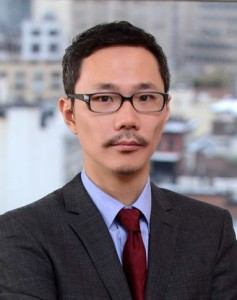
Shin Furuya, Vice President, Responsible Investment and Engagement Specialist, Domini Social Investments; Lead Research Analyst, Nia Global Solutions
United States
Where do you see opportunities for powerful, effective investing today?
Mr. Furuya: I see tremendous opportunities in renewable energy and energy efficiency, particularly in three areas where significant challenges exist. First is the recycling of materials used in renewable energy or energy efficient products such as PV panels, LEDs and wind turbines. The second is transformative renewable energy technologies in the areas of material processing such as cement making and steel making. The third is creative deployment of renewable energy and energy efficiency products.
It is essential for the renewable-energy and energy-efficient-product sectors to establish comprehensive materials-recycling programs to ensure stable supplies of raw materials, including rare-earth elements. There is also an opportunity for breakthrough innovations that can develop these technologies without use of rare earth elements. These could reduce life-cycle environmental footprints while helping to manage risks from the price volatility and procurement uncertainty of these raw materials. Assumptions of unlimited growth without understanding how to close materials recycling loops would be unsustainable.
The second area is the utilization of renewables energy during materials processing and recycling. Most industrial materials processing and recycling, such as steel making, paper milling, and cement or industrial gas (e.g., hydrogen) production, still require substantial amounts of fossil fuels, with massive climatic impact. We have started to see signs of breakthrough technologies that will transform these material production processes through the use of renewable energy sources such as solar and wind power.
The third area is the extensive and creative deployment of these technologies in innovative products such as PV-based charging stations for electric vehicles; solar-paneling built into bike lanes; building integrated photovoltaic materials, parking lots; and airborne or microwind power devices. These technologies will help bridge the gaps between renewable energy and other sectors such as transportation and telecommunication.
It is important that these deployments be achieved with climate disaster-risk assessments in mind in order to ensure that these infrastructures can withstand coming disasters or climatic shifts. Aging infrastructure that requires renovation or renewal combined with growing concerns regarding the physical impacts of climate change are creating a perfect storm that will facilitate the integration of sustainable technologies into resilient communities.
What sector has had the most significant impact on the renewable energy landscape thus far? Why?
Mr. Furuya: Many sectors have had major impacts, both in terms of opportunities as well as risks, but individual sector’s impacts vary significantly, depending on their specific geographic location and their policy and regulatory environments.
Without a doubt, the financial sector has played a significant role by (re-)directing vast amounts of investments into renewable energy using various asset classes. Venture capital in recent years has made substantial contribution to the emergence of innovative renewable technologies and businesses. Likewise, a rapid growth of equity investments in renewable energy companies and structured products for renewable energy projects has enabled the scaling-up of the renewable energy sector. The surge of interest in green bonds, although not entirely free of criticism, has raised awareness regarding the importance of renewable energy as well as the risks of climate change, thereby encouraging mainstream demand and the creation of a new market.
At the same time, it is also true that the renewable energy sector’s abilities to achieve rapid technological advancement and operational efficiency have resulted in continued cost reductions and offer promising competitive returns to investors. Furthermore, examples such as the recent successful expansion of the residential solar market in multiple countries has contributed to convincing more investors that the investment in solar is a viable long-term investment option, which as well signals a fundamental shift in the renewable market.
The effects of public policy and utility sector responses have been mixed. Various tax incentives or subsidies as well as quotas for electric utilities’ fuel generation mix have provided financial support, and bought some time, for the renewable sector. Conversely, the fear of ending such incentives, imposition of tariffs by foreign governments, and larger incentives for the fossil fuel industry have likewise played a critical role in making the renewable energy sector more resilient through innovation and creativity. Strong resistance to change from utilities in some countries has played an important role in triggering a sense of urgency within the renewable energy industry. This sense of urgency is for the development of rapid technological innovation as well as the development of techniques to bypass the electric utilities entirely by using distributed grid systems with creative financing schemes—combined with residential solar.
No one doubts that there is an underlying issue of increased material risks of climate change, and therefore, for the fossil fuel industry. Mounting scientific evidence compiled over decades by scientists and journalists has contributed to shape and shift perception of the risks surrounding climate change. Shifts toward policy making supportive of renewable energy and increased investments in renewable energy are as much risks for management as are identifying opportunities. These scientific findings became the basis for powerful social movements led by civil society organizations such as 350.org. By engaging individual and institutional investors and reinvigorating the debates over divestment of fossil fuels and reinvestment in cleaner energy sources, both the science and the organizations have thus facilitated the creation of stronger demand for renewable energy markets.
Debates about environmental issues and solutions are common among the public and governments. What role do you think investors could play in establishing active working relationships with all stakeholders to effectively address environmental challenges?
Mr. Furuya: Investors have been playing an active role in a wide range of issues and solutions among themselves as well as all other stakeholders for several decades, including debate over climate change. However, it is also true that many investors are still taking a very narrow approach by limiting concerns to portfolio-level risks, hence not fully acknowledging the physical, social, and environmental impacts of their investments. These narrow perspectives have resulted in investors’ tendency to engage disproportionately with companies, but not enough with other stakeholders, especially those most negatively affected.
By integrating broader perspectives regarding their social and environmental impact (e.g., assessing the possibility of specific corporate actions contaminating local drinking water sources, in addition to how much impact water contamination has on stock price), investors could further enhance their due diligence processes regarding risk management and better understand the extent of such impacts on other stakeholders, which would be helped by having a longer-term view. The only way to address enormous environmental challenges is through collective action. The confluence of portfolio risk and physical, environmental, and social risks allows deeper engagement that fully utilizes investors’ expertise and leverage with other stakeholders as a part of a larger community.
BIOGRAPHY
Shin Furuya is the vice president, Responsible Investment Research & Engagement specialist at Domini Social Investments LLC, a leading responsible and sustainable investment firm, based in NYC. He is currently focusing on identifying companies with disruptive technologies for Nia Global Solutions, a new investment strategy launched in 2013. He is also a voting member of Nia’s Portfolio Review Committee. Prior to his work on Nia, Shin was the lead research analyst for Domini’s funds. He continues to contribute to the training of analysts, oversees research processes, and redefines research framework and KPIs while still serving on the investment committee for equity funds as a voting member. In addition, he actively engages with companies, civil society groups, and governments on thematic as well as sector-specific issues as an engagement specialist.
Before joining Domini in 2006, Mr. Furuya was a research analyst for custom research projects for the Investor Responsibility Research Center and Institutional Shareholder Services, and lead researcher for governance advisory firms. Before that, he was the national coordinator for the Economic Relations and Human Rights Program and the Refugee Program at Amnesty International Japan, where he managed both national programs.
Mr. Furuya is a member of the advisory board of the EIRIS Conflict Risk Network and also consults and reports on ESG integration and research strategies. He holds a BA in political science and international studies from the University of Oregon, an MA in international relations with a focus on global markets and politics, and a certificate of advanced studies in environmental dispute resolution from the Maxwell School of Citizenship & Public Affairs, Syracuse University.
For more information, please see his LinkedIn profile.
 Download this article as a PDF
Download this article as a PDF

